When your team is trying to close deals of a certain size with high-level clients, being a great salesperson may not be enough.
Selling will only take your team so far. They’ll need to become consultants to get some deals across the line.
And the best way to become a consultant is to take a value-based selling approach.
Value-based selling sees your sales reps putting buyers first, focusing on their needs at every sales funnel stage. In doing so, buyers see your reps as trusted advisors who cut through all of the information in the market to help them find the best solution.
If you want to reap the rewards of putting buyers at the heart of your sales process, you need to add more value. This article will cover how you can implement value selling into your processes and close bigger deals.
What is value selling?
Value selling, also known as value-based selling or value-added selling, is a sales methodology that prioritizes your buyers’ needs and encourages sales reps to deliver value in every interaction.
In doing so, your reps become trusted consultants who buyers will turn to for advice on a range of topics — not just those that are related to your product.
With value selling, reps listen to their buyers’ needs and personalize their pitches accordingly. As a result, they highlight not your product’s features but the value your product brings to buyers. The product could have a range of market-leading features, but if the buyer isn’t interested in them, then your reps don’t bring them up.
This is one of the major ways that value selling differs from solution selling.
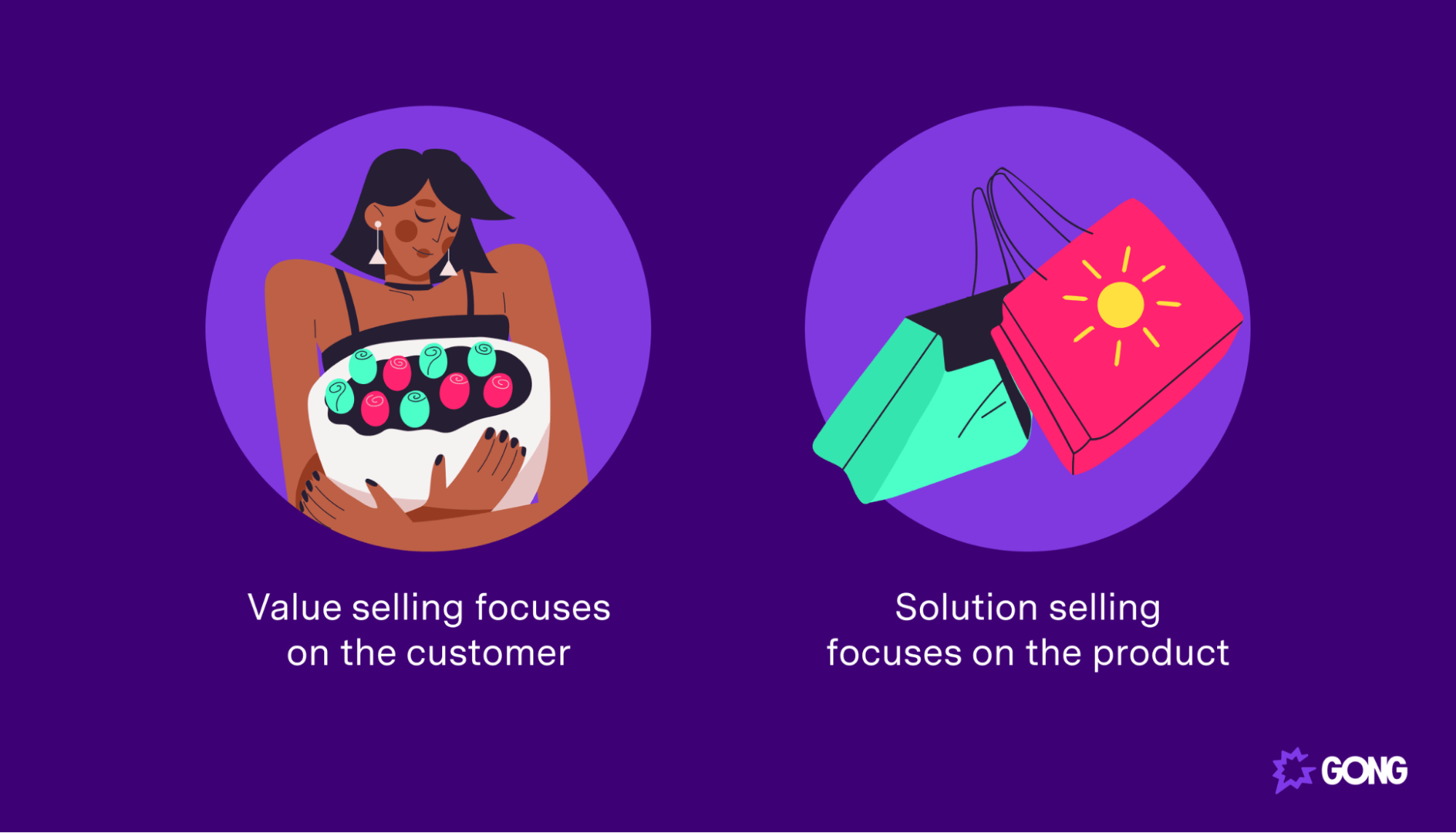
Value selling and solution both acknowledge that buyers are trying to solve a problem. The difference is in how sales reps help them solve it.
While value-added selling focuses on the buyer’s needs, solution selling focuses on your product’s features. In other words, solution sellers champion their products and value sellers champion their buyers.
Why adopt a value-selling solution?
There are several reasons 87% of high-growth companies adopt value-based sales compared to just 45% of negative-growth companies. Here’s why.
Puts the buyer first
Buyers want sellers to put their needs first. But only 23% of them think that sellers always put them first. That’s a huge gap that your reps can overcome with a value-based selling strategy that keeps buyers’ needs in mind throughout the sales process.
Builds long-term relationships
You want buyers to become buyers for life, right?
But that only happens when there is a trusted relationship between the buyer and the seller. Value selling builds the kind of trust that makes buyers stick around longer and refer other companies to your sales team.
Closes more deals
What buyer doesn’t want to work with a sales rep that prioritizes the buyer’s needs over the sale? By delivering value at every interaction, sales reps position themselves as the go-to person when buyers are ready to make a purchase.
A 7-step framework for value-based selling
If you want to turn your sales reps into value sellers, have them follow this seven-step framework.
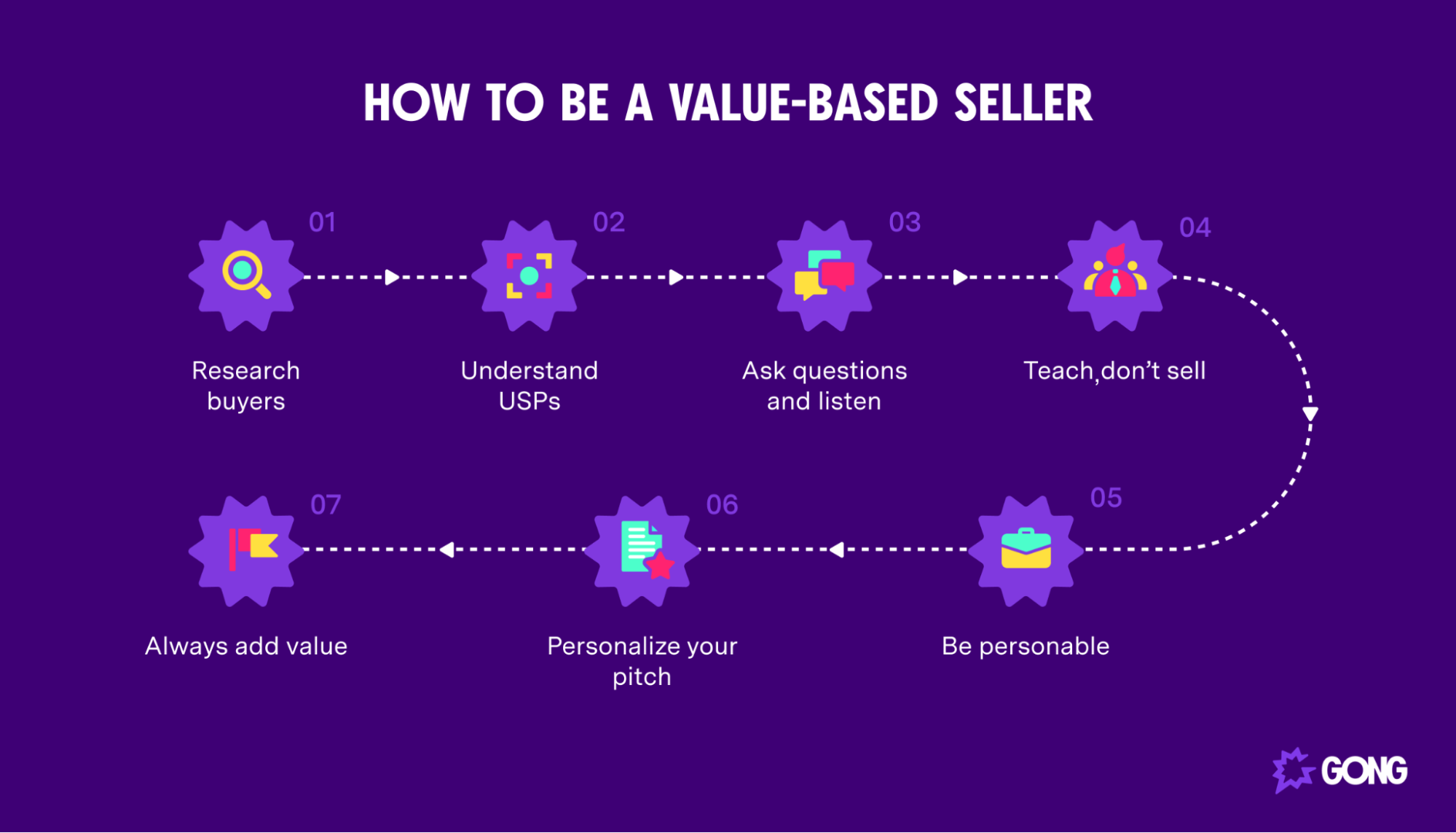
Let’s dive in.
1. Research buyers
Sales reps need to understand their buyers in order to put the buyers’ needs first. They can achieve this through in-depth research — research that should happen both before and during sales calls.
Before making the first call, the sales rep should scour the internet and your CRM for as much information about the prospective buyer as possible. Sites like LinkedIn and Crunchbase can give the sales rep a lot of data about the individual buyer and their company that they can use to guide their first call.
This research can even give your sales reps a way to add value on the very first call. Perhaps a prospect has complained about a particular problem on LinkedIn that your rep can help with, for instance. Or, the rep could introduce the buyer to someone else in the industry.
Research is made easier with strong ideal customer profiles (ICP) and buyer personas.
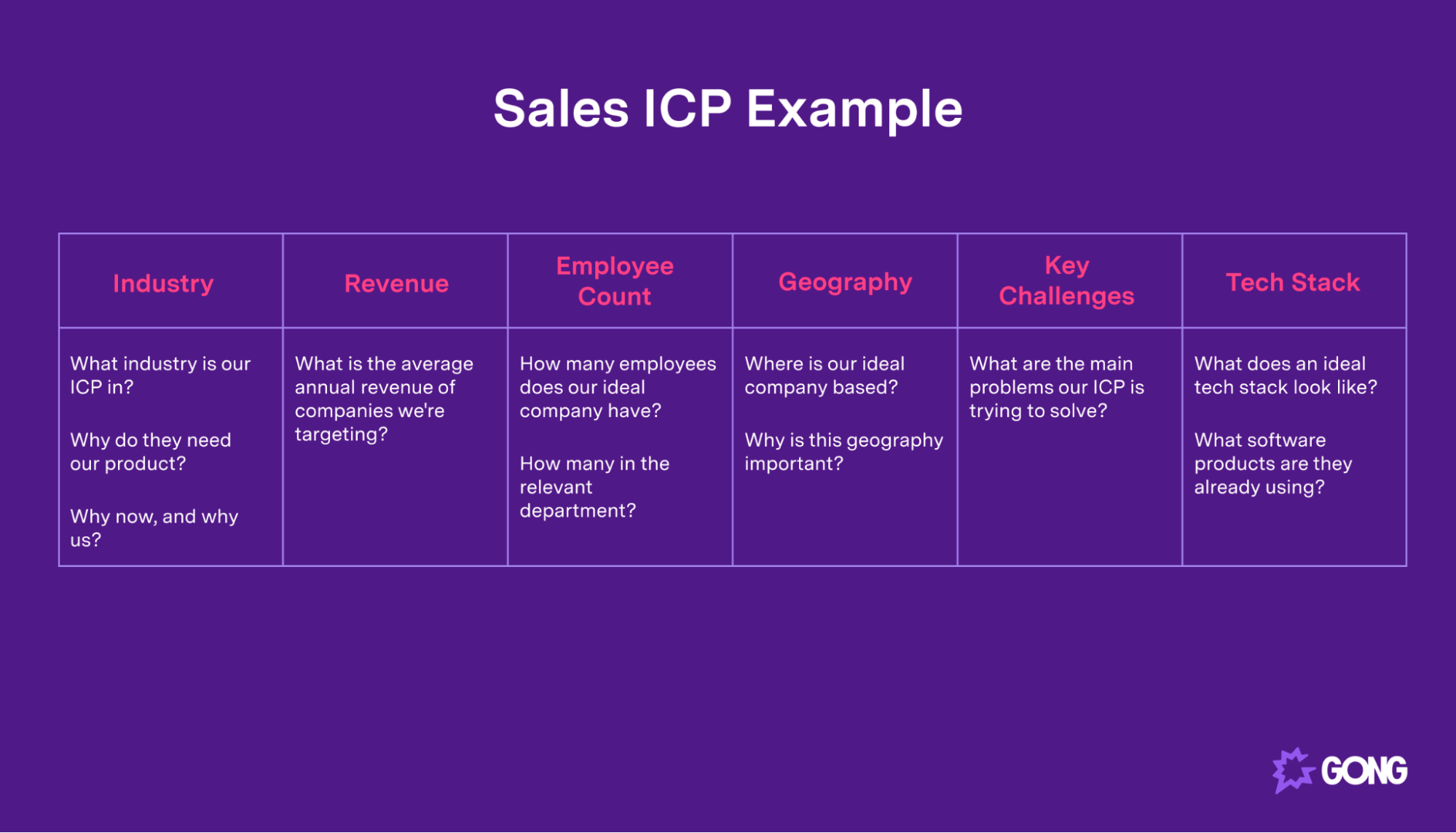
A well-defined ideal customer profile won’t just ensure your reps target prospects with a high propensity to buy, but it can also act as a checklist for conducting research. Sales professionals can go through your ICP or buyer persona point by point to make sure they have the relevant information before making the first sales call.
2. Understand USPs
Sales reps need to know their product like the back of their hand to be effective value sellers. It’s the only way they can highlight your product’s features and benefits in a manner that meets the buyer’s needs. After all, value-based selling is about the value your product can bring almost as much as the value your reps can add.
Understanding your product’s unique selling points (USP) — the features and benefits that set your product apart from everyone else’s in the market — is critical. The more USPs your reps can point out to buyers, the harder it will be for buyers to disagree that your product really can solve their problems.
3. Ask questions and listen
There’s only so much that your sales professionals can learn from researching before picking up the phone and making a call. That’s why they need to learn how to ask questions that get to the heart of their buyer’s pain points. In doing so, they can position your product as the solution to the buyer’s problems.
What kinds of questions should reps be asking? Lucky for you, we’ve put together a list of 10 of our favorite value-selling prompts that you can download for free.
Here’s a sneak peek of the questions on the cheat sheet:
- What’s your biggest strategic priority for this year, and what challenges might you run into along the way?
- What’s causing you to prioritize this as an initiative over other things on your list?
- What would be the impact if this problem isn’t solved?
Knowing what to ask is only half the problem. The other half is listening to the answers. In fact, active listening was the number-one attribute buyers most valued among salespeople.
The trouble is that a lot of salespeople don’t shut up and let the buyer talk. Not only does this make the buyer feel less valued, but it also means the rep doesn’t gather enough information.
Encourage your reps to strike a balance between talking and listening but to err on the side of listening over talking.
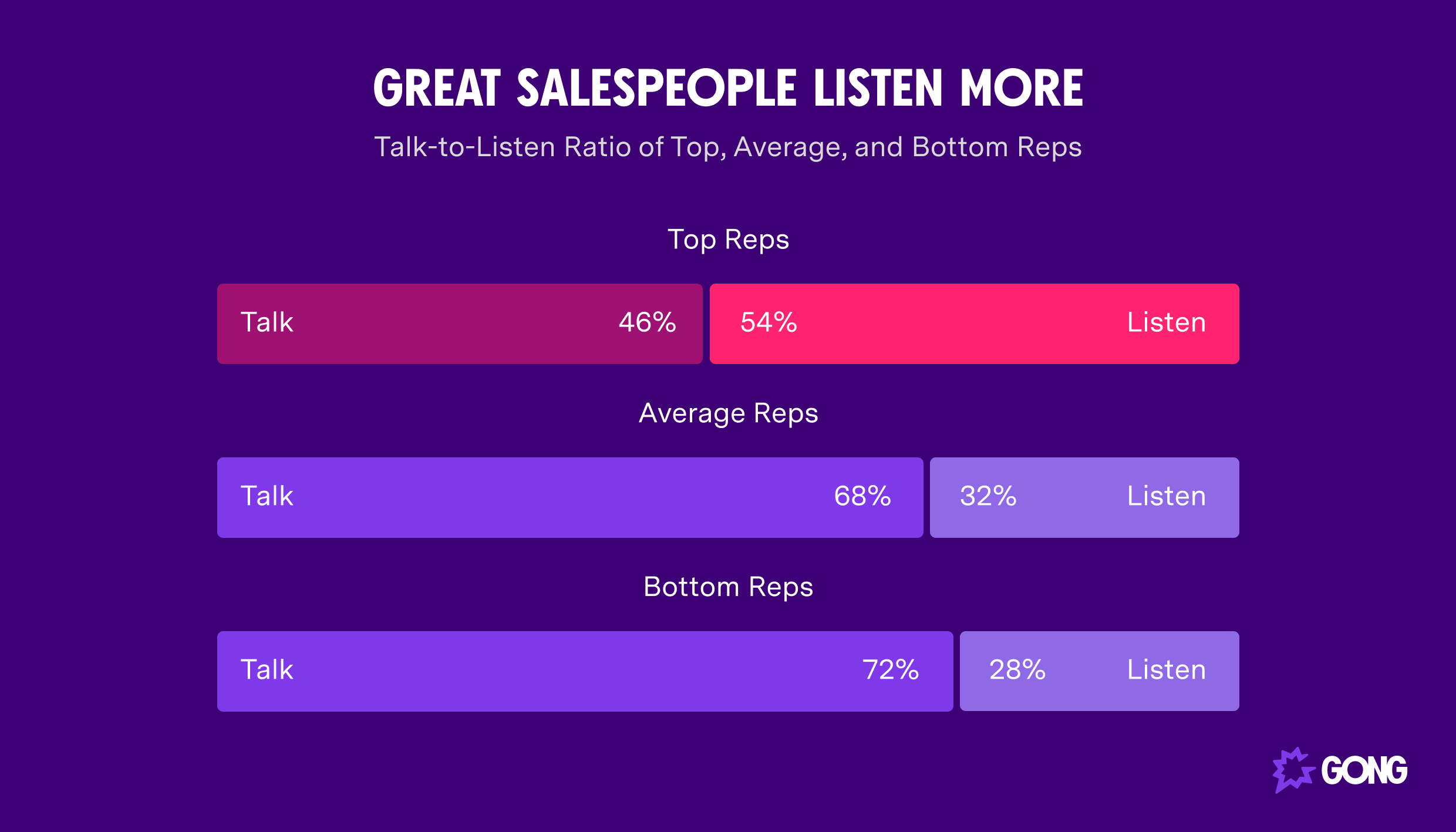
The best sales reps listen slightly more than they talk. Poor performers talk 72% of the time, whereas top-performing reps talk just 46% of the time.
4. Teach, don’t sell
Great value sellers position themselves as the go-to resource for buyers in their industry. They achieve this by offering value upfront — way before the negotiation stage. In other words, they teach rather than sell.
This may seem like a bit of a jump for sales reps used to pitching to prospects on the phone, but there are loads of ways they can become trusted advisors.
For instance, they can share industry-related research they’ve found while researching buyers. They can also share any blog articles or other resources they come across that they think the buyer may find useful.
In larger organizations, sales reps can work with the marketing team to create guides and articles that help their buyers solve a particular problem.
Sales reps can even share success stories from buyers that have already solved the problem a current buyer is facing.
Even when discussing your product’s features and benefits, reps should focus on teaching buyers rather than selling to them. By explaining how certain features work, reps can let buyers reach their own conclusions about the viability of your product without the buyer feeling like they’re being sold to.
Ultimately, the goal here is to become a fountain of knowledge — a trusted resource so that when the buyer is ready to make a purchase decision, your rep is the first person they call.
5. Be personable
Your reps need to be likable if buyers are to see them as trusted experts. To that end, reps shouldn’t come across as pushy salespeople; they should come across as the buyer’s friend.
But how can your reps be more personable?
It’s all in their phone manner.
Rather than making buyers feel like they’re part of the Spanish Inquisition, reps should focus on having a conversation, engaging in small talk, and asking open-ended questions. Encourage your reps to take a friendly tone — one that suggests they aren’t just there to make a sale.
Your reps don’t have to squeeze every bit of information out from the buyer on every call. If they do value selling right, there’ll be plenty of conversations from which they can gather the information they’ll need to personalize their sales pitch.
Sales reps should also be genuine, and that means being honest.
Sometimes, buyers aren’t going to be a good fit for your organization. If that’s the case, it’s important that reps tell them so. There’s no point in your reps wasting everyone’s time when a deal clearly isn’t going to close.
6. Personalize your pitch
When you take a value-based selling approach, no two pitches should be the same. Why would they be? No two buyers are the same, after all.
Every part of your reps’ pitches and product demos should be tailored to your buyers’ specific needs so that they continue to add value.
This means that personalizing your pitch can be as much about what you leave out as what you include. Your product probably has many amazing features that some buyers don’t need or want. If that’s the case, then the reps shouldn’t mention them. They should only pitch the features and benefits that can solve buyers’ issues.
Adding value through personalization should happen at every stage of the sales cycle. Continuing to focus on value is the best way to keep a deal moving.
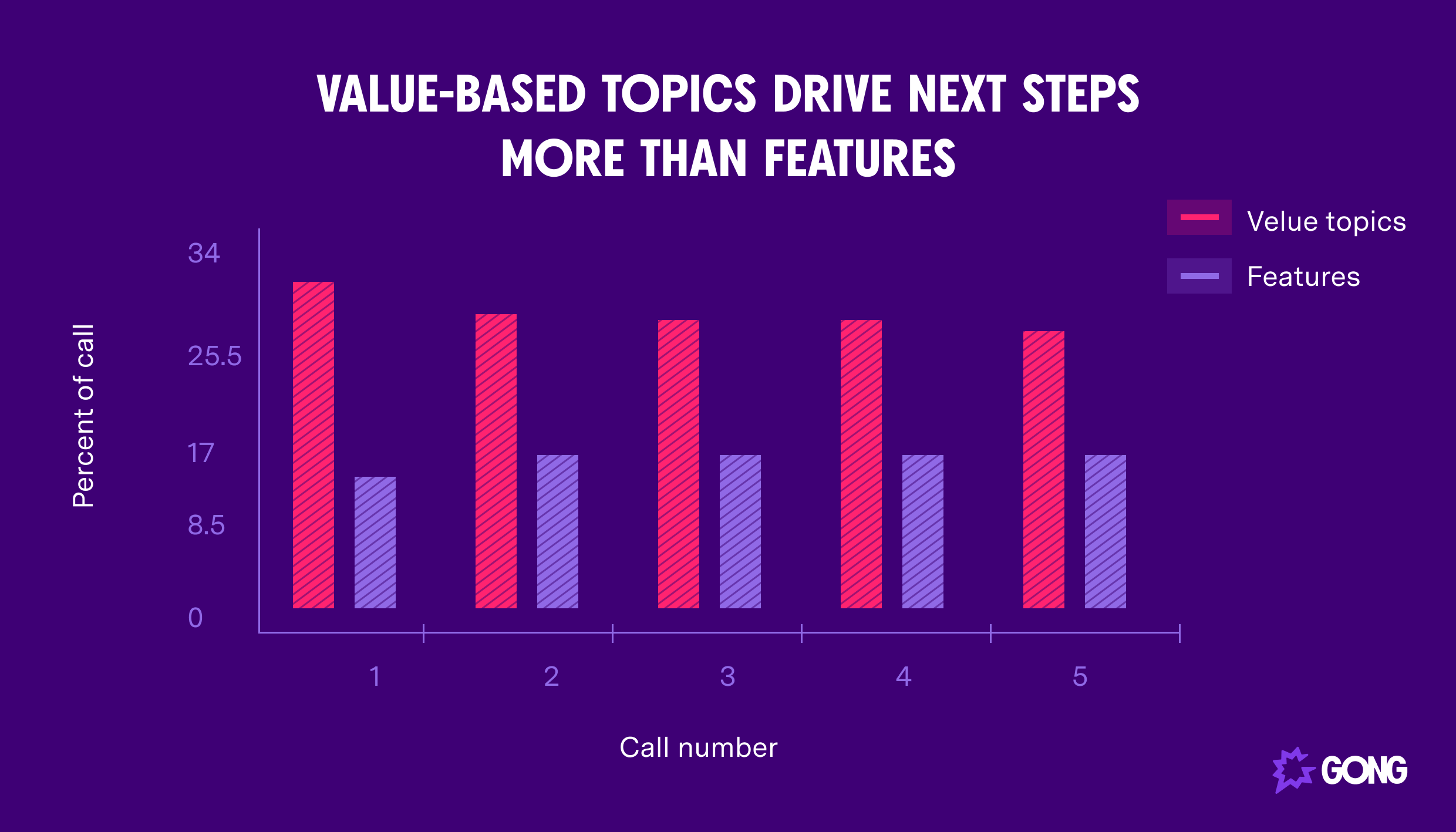
On most sales calls, reps will focus on two topics for discussion: value-based topics (business impact, use cases, etc.) and features-based topics (your product’s features).
Our research shows that reps are much more likely to get a follow-up call and move the deal forward if they focus on value-based topics.
7. Always add value
Sales reps that use a value selling framework should continue to add value during every interaction — including those interactions that happen after the deal has closed.
By continuing to add value after you’ve secured the buyer’s signature, you’ll significantly reduce the likelihood of them pulling out of the deal at the last minute. Your reps will also build greater customer loyalty that could potentially translate into higher customer lifetime value and more deals in the future. After all, if buyers can trust your sales rep to solve their problem, why wouldn’t they trust them again in the future?
Encourage your reps to continue adding value by:
- Sharing articles relevant to their business
- Checking in on buyers periodically
- Offering onboarding support
- Sharing product training guides and videos
- Connecting buyers with other professionals
Get more value with Gong
Putting buyers at the heart of your sales process isn’t a selfless act. Your team stands to close more deals and build stronger long-term relationships by doing so.
And you can add even more value to your value-selling process with Gong. Our revenue intelligence platform makes it easy to track performance and see how successfully reps are carrying out the steps we’ve listed above. Book a demo to find out more.
P.S. Don’t forget to arm your reps with our top 10 value-selling prompts to get to the heart of what your buyers care about and increase deal momentum.